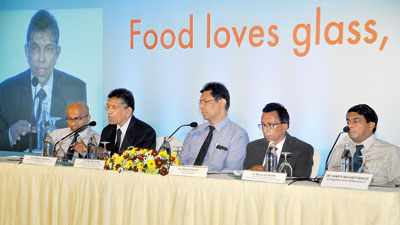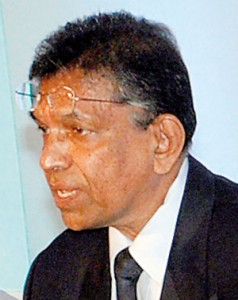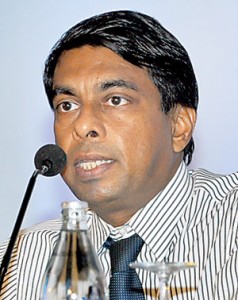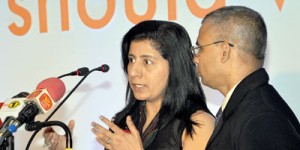News
Plastic peril

The panellists (from the right): Dr. Waruna Gunathilake, Dr. LakKumar Fernando, Dr. Neville Perera, Dr. Kolitha Sellahewa and Dr. Suranga Hettipathirana. Pix by Ranjith Perera The moderators: Dr. Mamta Jain and Dr. A.A.P. Keerthi
Plastic and its potential toxic or poisonous effects came under a powerful searchlight on Wednesday.
From the common and convenient bottles of water that we carry around or arm our children with, the feeding bottles that mothers tuck into the bags that they carry the stuff of their babies in, to the water tanks atop our roofs and even the pipes that bring water into our homes, all are made of plastic.
Reiterating that numerous studies across the world have raised concerns over the possible dangers of plastic, the President of the Sri Lanka College of Paediatricians, Dr. LakKumar Fernando pointed out that even though there may not be absolute proof, it is better to be careful and avoid using plastic as much as possible.
It is deemed a potentially hazardous material and it is âbetter to protect our babies from plasticâ whether in the womb or when the babies begin bottle-feeding after the essential breast-feeding period, said Dr. Fernando, who along with his colleagues has been taking a hard look at plastic feeding bottles since 2004.
Dr. Fernando was among five panellists, all medical specialists, that âBelievers in Glassâ had on the podium on Wednesday during a media conference at the JAIC Hilton, Colombo, to focus on the adverse effects of plastic.
The other panellists were the Head of the Toxicology & National Poisons Information Centre, Dr. Waruna Gunathilake; Consultant Physician Dr. Kolitha Sellahewa; Consultant Genito-Urinary Surgeon Dr. Neville Perera; and Consultant Obstetrician & Gynaecologist Dr. Suranga Hettipathirana. The moderators were Physician Dr. Mamta Jain from India in English and the Joint Secretary of the Institute of Chemistry Ceylon, Dr. A.A.P. Keerthi in Sinhala.
Interestingly, on the tables, taking the older journalists back in time to their childhood where glass was the material of the day, were quaint glass bottles of water instead of the now common plastic bottles. The invitation to the briefing was also delivered in an innovative way â instead of a letter in a bottle, it was a plastic snake in a plastic bottle to indicate that what flows from the bottle may be poisonous.
âIt is not an intelligent move to use plastic feeding bottles,â said Dr. Fernando, who created a picture of how paediatricians see numerous mothers doing so.

Dr. LakKumar Fernando
Suggesting that it would be a good idea to take a policy decision to phase out plastic feeding bottles, when asked, he said that even though glass bottles are breakable, if it is the better option, then mothers should be guided in that direction. All the test-tubes in chemistry laboratories are made of glass because it is the most inert (chemically-inactive) material and does not react with other materials.
As far back as 2004, Dr. Fernando had advocated that âit is prudent to avoid exposure of babies to potentially harmful chemicals in whatever amountsâ with regard to plastic.
He had argued that the safety of feeding bottles was riddled with controversy, as Bisphenol A (BPA) — an oestrogen-like substance that could have ill-effects on babies — may be leaching (draining) from those bottles. As such, they should be done away with. Some studies had shown that leaching could occur when the bottles are heated to 100C or more for 20-30 minutes and ironically boiling is the recommended method of sterilization. (Oestrogen is a female-hormone.)
Earlier, the panel discussion was launched with moderator Dr. Jain underscoring that leaching from plastic has become a global issue. âEverything around us and even inside us is plastic,â she said, citing the example of bottles of water, drinks and even medicines.
Quoting a study which had tested the urine and blood of humans and found that the samples contained plastic chemicals, she asked: âShould I be worried about it?â Answering that with a yes, she pointed out that other factors that could aggravate the leaching are the length of time a substance is kept in a plastic bottle and also the temperature at which a plastic bottle is stored. Storage temperature approval for such plastic bottles is usually 20C, but the temperature in Sri Lanka is higher.
Although plastic may come under such names as âfood-grade plasticâ or âsafe-plasticâ, global studies have shown that even these high-end plastics may leach dangerous compounds, it is learnt.
These dangerous compounds include hormone or endocrine-disruptors such as BPA (which mimics the female-hormone oestrogen); phthalates (which seem to have an impact on both oestrogen and the male-hormone testosterone); and heavy metals.
Before picking up hormone-disruptors, Dr. Kolitha Sellahewa explained that usually through the endocrine system, hormones which have specific roles to play in growth, development, sexual functions and even the mood of a person are released. Hormone-disruptors are extraneous chemicals which get into the human system and mimic these hormones but without the naturally in-built control mechanism which regulates the bodyâs endocrine system. âTherefore, hormone-disruptors play havoc within the body, derailing all the normally occurring processes.â
According to Dr. Sellahewa if an expectant mother is exposed to such chemicals, her child may develop asthma between the ages of 5 and 11 years. These substances may cause problems in fertility, conception, lead to miscarriages, impact on development, cause asthma and also obesity in young adults.

Dr. Kolitha Sellahewa
If there is resistance to insulin, diabetes will follow, he said, adding that the problems are âhugeâ. Even breast-cancer has been found to proliferate faster in those exposed to such substances.
Dr. Sellahewa explained that large studies had shown that phthalates are toxic to certain cells in the male testes, which produce sperm, thus causing a reduction in the sperm production which would lead to fertility issues. They are also toxic to other cells in the testes which produce the male-hormone testosterone.
Pointing out that 50% of miscarriages are due to genetic issues, Dr. Suranga Hettipathirana said that chemicals cause a lot of harm to genes. âGenes are the building-blocks of our system and if genes are affected, we may even pass on these issues to the next generation.â
Dr. Neville Perera said that in the past decade he has witnessed a rise in male infertility. What could be the cause, he asked, replying that it could be environmental issues or the food and drinks that we consume. It is not clear what exactly is causing male infertility but the sperm counts are low for no reason. It could be due to the chemicals in food and drinks including water. The chemicals leaching from plastic bottles may be a cause.
Dr. Perera said that an expectant mother needs to be aware of these dangers. If the foetus is a boy, a result could be fertility issues when he is older, while he could also be vulnerable to testicular cancer.
Going into detail about chemicals, Dr. A.A.P. Keerthi said that when they get into the body they exist there as âfree-form chemicalsâ or âbound-form chemicalsâ. Usually, the free-form chemicals get de-toxified while the bound-form chemicals can get into the environment in which the foetus is and release free-form chemicals within the womb. This could cause severe harm to the baby.
It was last year in February that the social movement, âBelievers in Glassâ was launched in Sri Lanka. Those who participated in the launch included officials from the Environment and Mahaweli Development Ministry, the Consumer Affairs Authority, the National Poisons Information Centre and the City Analystâs Office; and representatives from the Institute of Chemistry; Piramal Glass Ceylon PLC; and BBDO Lanka, an advertising agency.

Dr. Waruna Gunathilake

Dr. Suranga Hettipathirana

Dr. Neville Perera

The moderators: Dr. Mamta Jain and Dr. A.A.P. Keerthi
| Is the plastic used in Sri Lanka food-grade, at least? Plastic is everywhere, said Dr. Waruna Gunathilake, explaining that while it is derived from petroleum, the âbig questionâ is whether the plastic we use to store food and liquid is âfood-gradeâ. Strongly questioning whether Sri Lanka tests the standard of plastic, he gave the range — starting with small items such as spoons, cups and plates to pipes of polyvinyl chloride (PVC) and big items like plastic water-tanks. âThere are no standards and there is no testing of standards,â he lamented. Dr. Gunathilake stressed that even when a person buys a pastry or a cutlet, it is put into a plastic bag. Rice and curry is wrapped in plastic sheets. Are these made from food-grade material? What happens when the oil in the pastry mixes with whatever is leaching from the plastic bag, particularly those red and blue bags? What of straws, those âice packetsâ that children love to drink and also plastic containers which are supposedly microwave-usable? He also voiced concerns about melamine now commonly used as plates and cups in homes. Dr. Gunathilake sent out a strong appeal to the public. Dispose of plastic in the right manner, he pleaded, and that is to recycle it. âPlease donât burn plastic, even a small sili-sili bag, because you are releasing toxic fumes into the environment.â |

